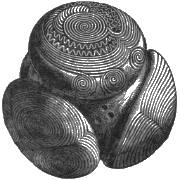NMS Archaeology Object 642642: X.2005.27.7 - Pottery / food vessel
Description
Summary
Intact bipartite vase food vessel with a stop-ridge groove, from cist B, Holly Road, Leven, Fife
Accession Number
X.2005.27.7
Other references
| Classification number | X.EQ 1119 |
|---|
Original description
[One of] Finds from excavations at Holly Road, Leven, Fife. ORF: IDENTIFICATION - Description: Finds from excavations at Holly Road, Leven, Fife. Description (after published catalogue entry by Sheridan): Intact bipartite Vase Food Vessel with a stop-ridge similar to X.2005.27.4 (X.EQ 1116) with the lowest quarter of the pot having a crudely-scratched, vertical chevron design. There is very minor ancient chipping on the rim and edge of the base; cracks appeared as the pot slowly dried out but were arrested during post-excavation consolidation. The everted rim has a narrow external bevel and a broad internal bevel. The neck is upright and slightly concave; the stop-ridge is virtually identical to and made in the same way as those of; X.2005.27.4 (X.EQ 1116) and the X.2005.27.6 (X.EQ 1118) pot; and there are four unperforated strap lugs. The belly narrows evenly towards the base, changing direction almost imperceptibly just above the wall-base junction to form a pedestal; the base is flat on the exterior and very slightly domed on the interior. Three-quarters of the exterior (except the stopridge), and the internal rim bevel, are decorated with impressions of twisted cord. The chevron design towards the base of the vessel is mostly shallow and was made with a narrow, organic tool leaving incisions about 1mm wide. The twisted cord impressions resemble those on the other similar pots in terms of the fineness of the cord, visibility of individual threads and overall width. The herringbone design, made using tightly-twisted cord, occurs on the neck and upper belly; the upper and lower edges of the stop-ridge also have short, opposing diagonal impressions forming the same design. Plain lines of more loosely-twisted cord impressions occur on the neck, where two pairs form a border for the herringbone. There are also four concentric lines on the internal bevel and, below these, a fringe of short, diagonal lines of tightly-twisted cord. Similar lines are present on the external bevel and on the lugs. The exterior is a variegated light to medium brown colour and the interior a light grey-brown to medium brown. In the tiny areas where the core is visible, it appears to be dark grey. The surfaces has been carefully smoothed and slipped prior to decoration although some stone inclusions are clearly visible on the interior surface, and a few also on the exterior. These are almost all of a blackish-brown, hard stone up to 5 x 6.5mm in size; the density is 5–7%. Their angularity indicates that the stone had been deliberately crushed and added as temper. There are no traces of the pot’s former contents. There are a couple of accidental impressions of organic material including straw, but no cereal impressions. Dimensions: height: 113mm; rim diameter: 138-143mm; base diameter: 70mm; wall thickness: 9-18mm. Context: Cist B: found lay on its side on the floor of the cist with its base against the W wall and its mouth and head towards the head and chest area of the body. Date: The surviving skeletal remains produced a date of 2040-1730 cal BC (GrA-22107) and surviving tooth enamel produced a date of 1740-1490 cal BC (GrA-21688) (see published report for details). FIELD COLLECTION - Place: Holly Road, Leven, Scoonie (Kirkcaldy), Fife. Grid Reference: NO 3783 0213. Site Type: Cist cemetery. Period: Bronze Age. Method: Excavation. NMRS no: NO30SE 1. Circumstances of Discovery / Notes: Excavations were undertaken in advance of the development of an area to the N of Leven where a cist burial was discovered in 1944. The recent investigations revealed an enclosed cist cemetery, radiocarbon-dated to the first two centuries of the second millennium BC. The cemetery appears to have had a short period of use when it received inhumation burials inside the ditched enclosure. A number of cists of poorer construction were uncovered outside the enclosure and a Neolithic cremation deposit was retrieved from within the ditch (Author’s abstract). In addition to the fusiform bead from the 1944 investigations (already registered as NMS: EQ 944), the cemetery produced the following: in Cist A were a flint knife, a fossil crinoid that had been used as a bead, and a Vase Food Vessel; in Cists B, C and K, one Vase Food Vessel each (with parts of two others being found in disturbed positions); and in Cist H, an unusually-shaped pebble that had probably been used as an amulet. NOTES and DOCUMENTATION - Bibliographic Reference: Christie, R L 'Short cist at Durie, Scoonie, Fife', Proc Soc Antiq Scot, 83 (1948-9), 230-1. Lewis, J and Terry, J ‘The excavation of an early Bronze Age cemetery at Holly Road, Leven, Fife’ Tayside & Fife Archaeological Journal 10 (2004). Registered / Completed By: Trevor Cowie. Date: 28.8.2006.
Associated person/people (e.g. excavator/former collection)
None
Discovery / field collection
Date of discovery
2002
Method (e.g. excavation)
Excavated
Place (i.e. location of discovery)
Leven, Fife, Scotland, Northern Europe
Grid reference
Not recorded
Acquisition
Acquisition date
2005
Acquisition source (i.e. name of donor)
Unknown
Acquisition source role (e.g. donor)
Donor
Image
None
Identifiers and Links to Other Records
Would you like to help find more links?
| Identifier / External Link | Linked Record | Status | Comment |
|---|---|---|---|
| Canmore Site Id: 31321 | SILLERHOLE, CARAVAN PARK - SCOONIE (KIRKCALDY) - CEMETERY (PREHISTORIC), CIST(S) (BRONZE AGE), CREMATION (PREHISTORIC), HUMAN REMAINS (PREHISTORIC), BEAD (JADE )(PREHISTORIC), BLADE (STONE)(PREHISTORIC), FOOD VESSEL (BRONZE AGE) | Definite | |
| NMS Accession Number: X.2005.27.7 | No linked record | Identifier supplied by NMS |
This area is visible only to logged in users.
